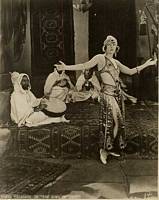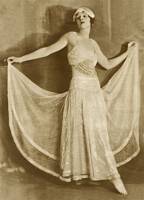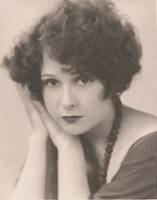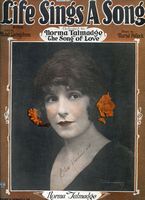

Song of Love (also called Dust of Desire) (1923) Norma Talmadge Productions/First National. Produced by Joseph M. Schenck. Directed by Chester Franklin and Frances Marion. Adaptation by Frances Marion. Photography by Tony Gaudio. Costumes, Clare West. Cast: Norma Talmadge, Joseph Schildkraut, Arthur Edmund Carew, Laurence Wheat, Maude Wayne, Earl Schenck, Hector V. Sarno, Albert Prisco, Mario Carillo, James Cooley. 8 reels. A copy of this film is held by the Library of Congress (35 mm.) and by the Czech film archive (35mm nitrate), and the Deutsche Kinematheque 35 mm.) and is available on video from Kino Lorber as part of the Pioneers: First Women Filmmakers set on disc 6
| The New York Times critic may have loved Norma's costume, but she doesn't look too sure about it. |  |
 |
A costume pose photographed by Melbourne Spurr |
| A portrait in costume, again by Melbourne Spurr |  |
| A sheet music cover |  |
First National attraction, starring Norma Talmadge. Presented by Joseph M. Schenck. Adapted from the Margaret Peterson novel, "Dust of Desire," by Frances Marion, who co-directed with Chester Franklin. Shown at the Rivoli, N.Y., week Feb. 21, 1924. Running time, 79 min.
| Noorma-hal | Norma Talmadge |
| Ramon Valverde | Joseph Schildkraut |
| Ramlika | Arthur Edmund Carewe |
| Dick Jones | Laurence Wheat |
| Maureen Desmond | Maude Wayne |
| Commissionaire Desmond | Earl Schenck |
| Chandra-lal | Hector V. Sarno |
| Chamba | Albert Prisco |
| Captain Fregonne | Mario Carillo |
| Dr. Humbert | James Cooley |
If you never got a real chance to see a lot of Norma Talmadge, this picture certainly gives it to you. Possibly Miss Talmadge is desirous of detracting attention from the rather tired look she is carrying about her eyes, so is exposing other of her charms. As the Arabian dancing girl she certainly does face the camera in a state of undress.
Outside of Miss Talmadge there isn't an awful lot to "The Song of Love." It is another of those desert stories, the same type more or less that went out of fashion a little over a year ago as far as the big first-run houses were concerned, at any rate. There is a lot of sand, some of the sheik stuff, some hard riding and gunplay, and above all Norma slips through a dance.
The scene is in Algeria, where a bold, bad chieftain of a desert tribe desires to be king of North Africa and to drive the unbelieving French from the territory. This role is played by Arthur Edmund Carewe, who presented a real heavy. Norma is a dancing girl in a native gaming house, and the chieftain desires to make her his queen when victory finally rests with his cause.
The French send for one of their secret service men to get the detail of the plot, and when he arrives in native disguise and enters the gaming house he wins the heart of the dancer. In the end she saves his life, and it all ends happily when the fanatic is killed and the girl saved from self-destruction, so that she can rest in the hero's arms.
The hero is played by Joseph Schildkraut, who makes a rather colorless job of it. Schildkraut won't do for pictures unless he gets roles different from the one here.
With Norma Talmadge as the star this is a picture you can play if they will stand for all that Norma shows--and they will. Without Norma it wouldn't be.
SONG OF LOVE, THE--First National. Norma Talmadge as an Arab dancing girl and very much worth while seeing (full review in March, 1924).
... Hitherto Norma Talmadge, who is listed as the highest salaried screen actress, has confined her pantomimic art to portraying the demure romantic heroine, the light of love to many a bold and amazingly successful hero. In "Ashes of Vengeance" she was cleverly effective, and she was charmingly sympathetic in "Smilin' Through." Now she is ... playing an utterly different type of damsel. She has thrown aside the role with sobs and smiles and appears as a tempestuous, brazen Ouled Nail dancing girl in a locale scorched by Algerian desert suns.
Imagine passing into the Rivoli with a vague impression of Miss Talmadge in poke bonnet and voluminous hoop skirts that jealously guard even her ankles from view, and suddenly beholding a startling vision of undeniable beauty, clad expensively, but not extensively. ... Her vitality and charm cannot be denied, as she performs in this attractive part. Some might even say that it is remarkable that Miss Talmadge did not attempt such a characterization and adopt this costume long ago.
Song of Love was not only written by Francis Marion, but also co-directed by her with Chester Franklin. One of the films following in the wake of The Sheik (1921), it is an Arabian spy story with Talmadge, incredibly named Noorma-hal, as a native dancing girl. As she vamps the ambitious Tuareg chieftain, she flashes between seductive and disgusted expressions, as well as genuine excitement at the idea of driving the "Christian dogs" from Algeria. She has reckoned without falling in love with a French spy--apparently she was not clued in by his laughably absurd Arab disguise, spit curls and all. Caught between her love for him, her jealousy of the married white woman who is also pursuing him, and her desire to see her people freed of their European colonial overlords, she tries to save both the chieftain (unsuccessfully) and the French spy before stabbing herself. The spy is told she will recover if she wants to, and the implication is that she will, though he hasn't shown in the course of the film which of the ladies he preferred. Though this could be classed as an adventure film, the Talmadge character is the emotional center of the film and has by far the most footage. Conforming to the hot-blooded stereotype of Arabs, she cries more unabashedly than usual as well as being more sexually aggressive, making this role something of a contrast to her usually more passive characters. The costuming was certainly a departure. The New York Times reviewer was beside himself with excitement. Perhaps he never thought of her as sexy. She does not seem to have been pleased with the experiment herself, for she never repeated it. It is a silly film, but expertly made and quite enjoyable.
Print viewed: 35mm from the Library of Congress.
Last revised, March 10, 2019